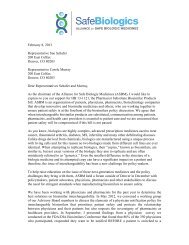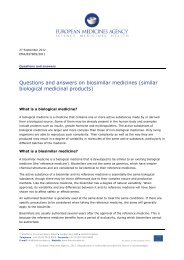Guide to Biological Medicines: A Focus on Biosimilar ... - Europabio
Guide to Biological Medicines: A Focus on Biosimilar ... - Europabio
Guide to Biological Medicines: A Focus on Biosimilar ... - Europabio
You also want an ePaper? Increase the reach of your titles
YUMPU automatically turns print PDFs into web optimized ePapers that Google loves.
<str<strong>on</strong>g>Biological</str<strong>on</strong>g> <str<strong>on</strong>g>Medicines</str<strong>on</strong>g><br />
A <str<strong>on</strong>g>Focus</str<strong>on</strong>g> <strong>on</strong> <strong>Biosimilar</strong> <str<strong>on</strong>g>Medicines</str<strong>on</strong>g><br />
Interchangeability<br />
Interchangeability of medicinal<br />
products refers <str<strong>on</strong>g>to</str<strong>on</strong>g> the situati<strong>on</strong><br />
where <strong>on</strong>e product can be<br />
interchanged for another<br />
equivalent product in a clinical<br />
setting, without the risk of a<br />
negative health outcome.<br />
In order <str<strong>on</strong>g>to</str<strong>on</strong>g> gain a marketing<br />
authorisati<strong>on</strong> in Europe, biosimilar<br />
applicants need <str<strong>on</strong>g>to</str<strong>on</strong>g> dem<strong>on</strong>strate<br />
similarity <str<strong>on</strong>g>to</str<strong>on</strong>g> the reference<br />
product. Assessments of<br />
interchangeability and<br />
substitutability are not part<br />
of the scientific evaluati<strong>on</strong> by<br />
the European <str<strong>on</strong>g>Medicines</str<strong>on</strong>g> Agency<br />
(EMA) and therefore, no<br />
c<strong>on</strong>clusi<strong>on</strong> <strong>on</strong> interchangeability<br />
or au<str<strong>on</strong>g>to</str<strong>on</strong>g>matic substituti<strong>on</strong> can be<br />
made based <strong>on</strong> the grant of a<br />
market authorisati<strong>on</strong>. Decisi<strong>on</strong>s<br />
<strong>on</strong> au<str<strong>on</strong>g>to</str<strong>on</strong>g>matic substituti<strong>on</strong> lie<br />
within the resp<strong>on</strong>sibility of the<br />
Member States. Unless products<br />
are designated as substitutable<br />
(see below), the decisi<strong>on</strong> as <str<strong>on</strong>g>to</str<strong>on</strong>g><br />
which product should be used<br />
and whether treatment should<br />
or could be changed <str<strong>on</strong>g>to</str<strong>on</strong>g> another<br />
product lies with the treating<br />
physician.<br />
Substituti<strong>on</strong><br />
Au<str<strong>on</strong>g>to</str<strong>on</strong>g>matic substituti<strong>on</strong> (or<br />
generic substituti<strong>on</strong>) is when a<br />
pharmacist substitutes a generic<br />
medicine for the brand name<br />
versi<strong>on</strong> of the same active<br />
ingredient, with no obligati<strong>on</strong><br />
<str<strong>on</strong>g>to</str<strong>on</strong>g> inform the treating physician.<br />
Some countries make generic<br />
substituti<strong>on</strong> manda<str<strong>on</strong>g>to</str<strong>on</strong>g>ry under<br />
certain c<strong>on</strong>diti<strong>on</strong>s, for example<br />
where the doc<str<strong>on</strong>g>to</str<strong>on</strong>g>r prescribes<br />
by INN.<br />
Generic substituti<strong>on</strong> is often<br />
linked <str<strong>on</strong>g>to</str<strong>on</strong>g> reimbursement, as<br />
some health insurance schemes<br />
will <strong>on</strong>ly reimburse the patient<br />
for the cost of the generic<br />
versi<strong>on</strong> of a product. The result<br />
of this can be that a patient who<br />
refuses the generic versi<strong>on</strong> and<br />
insists <strong>on</strong> the original product<br />
may be liable <str<strong>on</strong>g>to</str<strong>on</strong>g> pay the difference<br />
in cost. Generic versi<strong>on</strong>s<br />
of chemical pharmaceuticals<br />
that have dem<strong>on</strong>strated their<br />
bioequivalence may generally<br />
be substituted with no risk<br />
<str<strong>on</strong>g>to</str<strong>on</strong>g> patient safety.<br />
However, the EMA has<br />
specifically stated that "since<br />
biosimilars and biological<br />
reference products are not<br />
identical, the decisi<strong>on</strong> <str<strong>on</strong>g>to</str<strong>on</strong>g> treat a<br />
patient with a reference product<br />
or biosimilar medicine should be<br />
taken following the opini<strong>on</strong> of a<br />
qualified health professi<strong>on</strong>al".<br />
The physician’s involvement is<br />
particularly relevant, as not<br />
all biological medicines will<br />
necessarily have the same<br />
indicati<strong>on</strong>s, administrati<strong>on</strong><br />
schedules, administrati<strong>on</strong><br />
devices or side effect profiles.<br />
Furthermore, if au<str<strong>on</strong>g>to</str<strong>on</strong>g>matic<br />
substituti<strong>on</strong> were <str<strong>on</strong>g>to</str<strong>on</strong>g> take place,<br />
it could c<strong>on</strong>found pharmacovigilance<br />
when adverse reacti<strong>on</strong>s<br />
occur, especially immune reacti<strong>on</strong>s,<br />
as it is more difficult <str<strong>on</strong>g>to</str<strong>on</strong>g><br />
evaluate which product is<br />
resp<strong>on</strong>sible for the reacti<strong>on</strong> if<br />
the product has been repeatedly<br />
switched during treatment.<br />
A number of countries have<br />
either established legislative<br />
measures <str<strong>on</strong>g>to</str<strong>on</strong>g> prohibit the<br />
au<str<strong>on</strong>g>to</str<strong>on</strong>g>matic substituti<strong>on</strong> of<br />
biological medicines or have<br />
given regula<str<strong>on</strong>g>to</str<strong>on</strong>g>ry advice <strong>on</strong> the<br />
use of biologics (including<br />
prescripti<strong>on</strong> by brand names).<br />
Based <strong>on</strong> the above, countries<br />
that currently allow au<str<strong>on</strong>g>to</str<strong>on</strong>g>matic<br />
substituti<strong>on</strong> of biologicals should<br />
take the necessary measures <str<strong>on</strong>g>to</str<strong>on</strong>g><br />
s<str<strong>on</strong>g>to</str<strong>on</strong>g>p this practice in the absence<br />
of data that dem<strong>on</strong>strate interchangeability.<br />
Therefore, any<br />
change of treatment with a<br />
biological medicine should<br />
currently <strong>on</strong>ly be made under<br />
close medical supervisi<strong>on</strong> by<br />
the physician, with the patient’s<br />
c<strong>on</strong>sent.<br />
Impact <strong>on</strong> Healthcare<br />
Budget and Pricing<br />
Generics and biosimilars have an<br />
important role <str<strong>on</strong>g>to</str<strong>on</strong>g> play <str<strong>on</strong>g>to</str<strong>on</strong>g> foster<br />
competiti<strong>on</strong> in the marketplace,<br />
c<strong>on</strong>tributing thereby <str<strong>on</strong>g>to</str<strong>on</strong>g> the sustainability<br />
of healthcare budgets.<br />
Price reducti<strong>on</strong>s for biosimilars<br />
are generally not as those for<br />
generic medicines for a number<br />
of reas<strong>on</strong>s. Firstly, biological<br />
medicines, including biosimilars,<br />
are generally more complex and<br />
costly <str<strong>on</strong>g>to</str<strong>on</strong>g> produce and develop.<br />
Sec<strong>on</strong>dly, the regula<str<strong>on</strong>g>to</str<strong>on</strong>g>ry approval<br />
requirements and post-marketing<br />
surveillance for biosimilars are<br />
more rigorous than for generic<br />
medicines, thus adding a further<br />
layer of cost <str<strong>on</strong>g>to</str<strong>on</strong>g> developing a<br />
biosimilar (e.g. unlike generics,<br />
biosimilars usually require<br />
independent n<strong>on</strong>-clinical and<br />
clinical trials <str<strong>on</strong>g>to</str<strong>on</strong>g> be undertaken).<br />
Therefore, R&D costs required<br />
for the approval of a biosimilar -<br />
ranging <strong>on</strong> average from USD<br />
75 <str<strong>on</strong>g>to</str<strong>on</strong>g> USD 250 (approximately<br />
€50 <str<strong>on</strong>g>to</str<strong>on</strong>g> €170 milli<strong>on</strong>) 2 - are much<br />
higher than those for a generic.<br />
The exact price level of a<br />
biosimilar will depend <strong>on</strong> a<br />
number of fac<str<strong>on</strong>g>to</str<strong>on</strong>g>rs, namely the<br />
pricing and reimbursement<br />
envir<strong>on</strong>ment of each country,<br />
competitiveness of the market<br />
and the desire <str<strong>on</strong>g>to</str<strong>on</strong>g> encourage<br />
the future development of<br />
new products.<br />
Currently the number of<br />
biosimilars is low partly because<br />
<strong>on</strong>ly a few biological medicines<br />
have lost their market exclusivity.<br />
Potential savings, due <str<strong>on</strong>g>to</str<strong>on</strong>g> their<br />
lower list prices, are therefore<br />
limited as the products compete<br />
in market segments that <strong>on</strong>ly<br />
represent a small porti<strong>on</strong> of <str<strong>on</strong>g>to</str<strong>on</strong>g>tal<br />
healthcare expenditure.<br />
The regulati<strong>on</strong> of<br />
biological in Europe,<br />
including biosimilars<br />
Depending <strong>on</strong> the disease<br />
category, chemical medicines<br />
can be approved either by the<br />
nati<strong>on</strong>al medicines authorities<br />
of the individual EU Member<br />
States or by the "centralised<br />
procedure" for approval carried<br />
out by the European <str<strong>on</strong>g>Medicines</str<strong>on</strong>g><br />
Agency (EMA). In c<strong>on</strong>trast,<br />
all new biological medicinal<br />
products, including biosimilars,<br />
have <str<strong>on</strong>g>to</str<strong>on</strong>g> follow the centralised<br />
procedure.<br />
Applicati<strong>on</strong>s submitted <str<strong>on</strong>g>to</str<strong>on</strong>g> the<br />
EMA are assessed by its<br />
Committee for Human Medicinal<br />
Products (CHMP), which can give<br />
a positive or negative opini<strong>on</strong>.<br />
Up<strong>on</strong> receipt of a positive<br />
opini<strong>on</strong> from the EMA, the<br />
European Commissi<strong>on</strong> issues a<br />
marketing authorisati<strong>on</strong>, which is<br />
valid for all EU Member States.<br />
Since 2003, the European<br />
Uni<strong>on</strong> has created a legal and<br />
regula<str<strong>on</strong>g>to</str<strong>on</strong>g>ry pathway <str<strong>on</strong>g>to</str<strong>on</strong>g> enable<br />
the development and marketing<br />
of biosimilar medicines.<br />
Directives 2003/63/EC and<br />
2004/27/EC created the<br />
legislative route and the EMA<br />
has subsequently developed a<br />
number of regula<str<strong>on</strong>g>to</str<strong>on</strong>g>ry guidelines<br />
c<strong>on</strong>cerning the data required for<br />
the approval of a biosimilar.<br />
The EMA defines biosimilars in "Questi<strong>on</strong>s and Answers <strong>on</strong> biosimilar medicines" as:<br />
Besides the "overarching"<br />
general guidelines <strong>on</strong> biosimilars,<br />
the EMA has also developed<br />
guidelines <strong>on</strong> quality, n<strong>on</strong>-clinical<br />
and clinical issues, as well as<br />
product-specific guidelines<br />
annexes (for example insulin,<br />
epoetin, somatropin, granulocytestimulating<br />
growth fac<str<strong>on</strong>g>to</str<strong>on</strong>g>r,<br />
interfer<strong>on</strong>-alfa and low-molecular<br />
weight heparin). At the time of<br />
publicati<strong>on</strong> of this document,<br />
further guidelines are being<br />
prepared, including guidelines<br />
<strong>on</strong> follicle stimulati<strong>on</strong> horm<strong>on</strong>e,<br />
interfer<strong>on</strong>-beta and m<strong>on</strong>ocl<strong>on</strong>al<br />
antibodies.<br />
The EMA's "overarching"<br />
guidelines <strong>on</strong> biosimilars<br />
specifically state that biosimilar<br />
products are "by definiti<strong>on</strong>"<br />
not generics, and that the<br />
generic approach <str<strong>on</strong>g>to</str<strong>on</strong>g> approval<br />
"is scientifically not appropriate"<br />
for biosimilars.<br />
2. Industry average source: Sandoz internal<br />
estimates. C<strong>on</strong>versi<strong>on</strong> in € d<strong>on</strong>e in July 2011<br />
"A biosimilar medicine is a medicine which is similar <str<strong>on</strong>g>to</str<strong>on</strong>g> a biological medicine that has<br />
already been authorised (the 'biological reference medicine'). The active substance of<br />
a biosimilar medicine is similar <str<strong>on</strong>g>to</str<strong>on</strong>g> the <strong>on</strong>e of the biological reference medicine.<br />
<strong>Biosimilar</strong> and biological reference medicines are used in general at the same dose <str<strong>on</strong>g>to</str<strong>on</strong>g><br />
treat the same disease. Since biosimilar and biological reference medicines are similar<br />
but not identical, the decisi<strong>on</strong> <str<strong>on</strong>g>to</str<strong>on</strong>g> treat a patient with a reference or a biosimilar<br />
medicine should be taken following the opini<strong>on</strong> of a qualified healthcare professi<strong>on</strong>al.<br />
The name, appearance and packaging of a biosimilar medicine differ <str<strong>on</strong>g>to</str<strong>on</strong>g> those of the<br />
biological reference medicine."<br />
Furthermore, the EMA Questi<strong>on</strong>s and Answers document states that the "legislati<strong>on</strong> defines<br />
the studies that need <str<strong>on</strong>g>to</str<strong>on</strong>g> be carried out <str<strong>on</strong>g>to</str<strong>on</strong>g> show that the biosimilar medicine is similar and<br />
as safe and effective as the biological reference medicine". To this end, the biosimilar<br />
approval pathway requires the manufacturer <str<strong>on</strong>g>to</str<strong>on</strong>g> dem<strong>on</strong>strate similarity with the reference<br />
product for quality, safety and efficacy. Specifically, the biosimilar must dem<strong>on</strong>strate that it<br />
has no significant clinical differences <str<strong>on</strong>g>to</str<strong>on</strong>g> the reference product. <strong>Biosimilar</strong> manufacturers must<br />
provide all of the n<strong>on</strong>-clinical, pre-clinical and clinical data required <str<strong>on</strong>g>to</str<strong>on</strong>g> dem<strong>on</strong>strate the<br />
similarity of their product <str<strong>on</strong>g>to</str<strong>on</strong>g> the reference product, without the need <str<strong>on</strong>g>to</str<strong>on</strong>g> repeat unnecessary<br />
tests and trials.<br />
07 08





